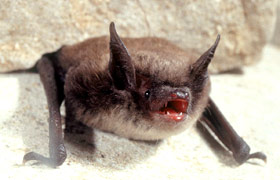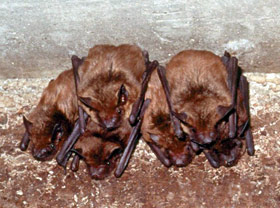Little Brown Bat, Myotis lucifugus; Big Brown Bat, Eptesicus fuscus

Little brown bat. USDA Forest Service Southern Research Station Archive, USDA Forest Service, SRS, Bugwood.org.
IPM Steps to Reduce Bats
1. Sample for Pest
Where to find it while inspecting: Bats are rarely a target of routine inspections but may be discovered while inspecting structures for any sign of entry way for other pests such as rodents and insects. Bats can be particular about their roosts but often find themselves inside unintentionally. If this happens inside the school, it is likely the bat would like to get out as much as you’d like to see it gone. If there is any suggestion of an established roost, use caution: gloves and masks (there is a risk of disease from both the animal itself and its droppings). NOTE: if there is any chance a bat has come in contact with a pet or human, it should be captured and taken to your local county health department for testing in case it has rabies. See VIDEO for safe capture technique.
2. Proper ID
Size and Particulars: Little brown bat: 3 1/8"–3 5/8" long including tail, wingspread 9–10 5/8" wide, glossy brown hair, ears long. Big brown bat: 4 1/8–5" long including tail, wingspread 12–14" brown hair, belly paler, wing skin black.
3. Learn the Pest Biology
Life Cycle: Females produce young (little brown bats generally one offspring, big brown bats generally bear two) in late spring or summer. Young are not weaned until they are a month old but stay at the roost for another month. Bats are long-lived, active with night-feeding until winter when they seek winter shelter for hibernation.
Preferred Food Sources: Flying insects
Preferred Habitat: Bats prefer buildings near a water source for both drinking and availability of insects. They also desire structures that remain dark, are warm, and have access holes of 1/4–1/2": notably attics, roof rafters, voids between walls, drip edges, roof corners, chimneys, vents, soffits, eaves.
4. Determine Threshold

Big brown bats. USDA Forest Service Southern Research Station Archive, USDA Forest Service, SRS, Bugwood.org.
Threshold: The incidence of one or two bats inside an occupied room or building is almost always by accident and does not mean you have a bat problem or a roost site. If bats are found to be living inside a structural wall or attic action must be taken because of the accumulation of bat excrement (a health concern). If very late in the season, you may choose to wait until they have left for a hibernation site. Actions taken at night mean fewer bats inside. Consult a professional pest control officer familiar, particularly one who specializes in wildlife/vertebrate pests. You may have to examine roost population both in daytime and evening.
5. Choose Tactics
Best Management Practices: Exclusion is the number one way to reduce a chance of bat infestation and is accomplished by examining every possible place that a small 1/2" could be found. Block the holes with “metal mesh” or expanding foam products. Keep in mind you are also excluding other pests such as wasps, mice and stink bugs, so be thorough. Plastic bird netting also works to keep bats away off of exterior walls and away from access points. Bright lights used inside a roosting site will deter the bats from returning but must flood all areas with light, not create shadows.. Ultrasonic devices are not known to work in deterring bats. If one bat is found inside a building, close off that area if possible and leave a door or window open (primarily at dusk or dawn).
Treatment Methods: Bats are protected due to their predatory benefit against mosquitoes and other flying pest insects and must not be treated with poisons—it is illegal and dangerous as dead bats can poison domestic animals. To manage bats: examine structure for entryways, determine the size of the nesting colony and the species. Counts may also be done by counting the number of bats exiting a roost—start a half hour before dusk and continue up to an hour after. Do not exclude a colony while young are roosting (mid-May to mid-Sept) as this will likely kill some bats and force others to exit into the interior of the building.
6. Evaluate
Was the tactic successful? Record the date pests were first noted, and the tactic you used, and its success. Use one of our RECORD KEEPING tools.
For More Information
Catch a Bat Safely Video (download link is in upper left corner of screen)
Remember:
When a pesticide application is necessary, all necessary and required precautions are taken to minimize risk to people and the environment and to minimize risk of pesticide resistance or pest resurgence. Pesticide use in your school may be prohibited or regulated by local policies or state and federal regulations. Risk reduction methods can include, but are not limited to, spot-treatment, the use of gel or paste bait formulations placed in inaccessible locations, injection into a crack or crevice, and other methods that reduce potential exposure.